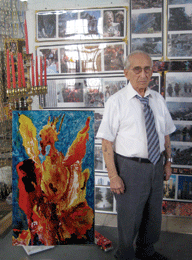I’m re-posting my front-page Jewish Week article from this week, about a ridiculously interesting Bronx relic — and his works of art. This is an entirely unknown museum that’s entirely worth visiting, despite the sketchy walk to and from either the Tremont or Burnside Ave. subway stations. In retrospect, I should’ve shelled out the few extra dollars for MetroNorth, which would’ve dropped me off just across the street from the museum, rather than trekking alone through the neighborhood that has the highest imprisonment rate in all of the Bronx and crack/heroine rings at every other corner. But anyway, see my article below.
The Jewish Picasso Of Tremont
Hidden behind rows of shoddy warehouses, auto-repair junkyards and single-room-occupancy tenements, the Museum of the People of the World is largely invisible to the sporadic passersby in its gritty Bronx location, just east of the Grand Concourse and down the hill from the jagged bedrock of Tremont’s Echo Park.
The museum of what, you say? Where?
In a city of museums — from one on sex to one on biblical art — you won’t find this one in any museum index or listing, in print or online.
The quirky, intensely personal museum, which carries the New Age-y subtitle “A Sanctuary for All Who Enter†and only recently opened to the public, is a testament to one man’s creativity, vision and, perhaps, obsession. It houses hundreds of works, in a dizzying array of media, all made by the hands of 91-year-old Herbert Lagin — a tinkerer, inventor and self-taught “outsider†artist. In a huge storage space adjacent to the lamp-manufacturing facility Lagin has owned and operated for the past 60 years, the works memorialize the Holocaust, 9/11 and religious refugees.
A nondescript door marked “4269†leads inside the facility, which occupies the rear of the bright-orange Western Beef factory outlet. Once inside, past the pastel blue corridor, its paint peeling, a sun-filled and brightly lamp-lit section of the warehouse contains tri-fold screens filled with abstract paintings, chain links dangling from the ceiling and original glasswork scattered here and there. Admission is free, and any donations go to various causes around the world, most recently Haiti.
“He actually redesigned the space with all sorts of machinery and everything — it’s really amazing he did this on his own,†says Lagin’s daughter, Robin Langsam, who is one of five children and is a teacher in Armonk. “He created the vision of it and really followed through.â€
A widower, Lagin lives in Great Neck, L.I., but drives in to Tremont several days a week to work in his factory-turned-museum. He says he conceptualized this museum just in the past few years, has been creating artwork since the third grade, when he’d reproduce pictures from classroom textbooks. The son of Russian Jewish immigrants, Lagin graduated from Long Island University while working in a lamp factory and was poised to head to medical school when the Great Depression struck. Foregoing medical school in an effort to support his parents, Lagin continued working at the lamp-manufacturing facility and eventually opened his own factory in the 1950s and purchased other Tremont properties. In addition to his artwork, Lagin has been something of an inventor, acquiring patents for a lamp-mounting tool, a recovery pillow for open-heart surgery patients and forge-proof traveler’s checks, among other items, although never actually marketing these products.
“He’s always been ingenious and creative, even doing something as simple as taking out his little pocketknife and making handles on boxes,†Langsam says. She then maps her father’s artistic trajectory from mixed media to watercolors to copper to etched glass and today, to markers, Cray-Pas and collages.
“You find people who late in their life, when they finish what they’ve had to do for a living, really take on this amazing outburst of original and quite extraordinary artistic expression,†says Selig Sacks, a trustee of the American Folk Art Museum who in 2009 was named one of the top 250 collectors in Art & Antiques Magazine. Sacks examined 40 photos of Lagin’s work, at the request of The Jewish Week.
Near the entrance to the museum, a panel of photographs features twilight snapshots from Lagin’s Great Neck, L.I., backyard of what appears to be the Star of Bethlehem, the star that revealed the birth of Jesus to the magi in Christian tradition. Nearby is a wall spread of framed black-and-white photographs from the U.S. government’s Holocaust archives, to which Lagin has added color and replaced some of the victims’ heads with those of figures like Iranian President Mahmoud Ahmadinejad and Islamic terrorists. “That’s [Ahmadinejad] — him as a Jew,†said Lagin, who may well be the only Jewish regular in the largely Hispanic and African-American Tremont neighborhood. “Everybody’s a Jew based on history.â€
Around the space hang black chain links symbolic of wartime bondage, and behind the photographs mixed colors of paint trickle down the wall like blood. In a corner hangs a wooden cutout of a man, dangling from the ceiling on a hangman’s noose. Â Continue reading…
_ _
Sharon Udasin is a staff writer at The Jewish Week. Follow her on Twitter or e-mail her at sharon@sharonudasin.com.
- @HerzilyaConf goes live on social networks - 11/30/2010
- My first “intercourse†with socialized healthcare - 10/7/2010
- Uniting Jewish Art: SUDINmagazine - 9/20/2010







This website has lots of extremely useful information on it! Thank you for informing me. I have to admit that I was interested in the look of your blog but it is really quite appealing. Awesome job, continue the good work